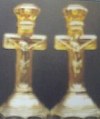Carnival Glass 101 | home Quick Reference to Carnival Glass Patterns on This Site
Iridescent Hatpins
IRIDESCENT HATPINS
Predating our Dragonlady (aka: Ardonna Bucher), Dr. Chris Reynolds was the Dragon and Lotus “reigning collector”. Ardonna purchased that collection not long before Chris passed away, as a start towards what has become the largest known collection in that pattern.
Dr. Reynolds' wife, Jerry, specialized for many years in buttons and hatpins. Her interest included updating some information on the subject which had been written by the pioneers: Lillian Baker, Marion Hartung and Rose Presznick. Jerry shared her knowledge by writing periodically for ICGA, Pacific Northwest and the San Diego Club Newsletters. Much as any writer should be, Jerry always was open to discussion , corrections, suggestions, and additional information which would help her, along with every other collector…………..As we approach this specialized field which predates carnival glass production as most of us know it, in the form of bowls, plates, watersets, etc., we believe that you will benefit from the following article written by Jerry along in the `80s time frame. She published a book on hatpins in 1994.
Additional note: Dean & I joined the Southern Cal. Club in 1981. At that time, a couple who came to the meetings regularly, always had “boxes” of old carnival glass hatpins to sell. Asking where they had secured such a “cashe”, we were told that a friend of theirs had recently rented a section of an old warehouse in New York City, where a millinery business had once prospered. Several boxes of about 30 each; iridized hatpins were discovered on a shelf, having been left there since before 1900, possibly.
Germany and Czechoslovakia are believed to have been sources of manufacture. Some hatpins have been found marked with the word “Geschutzt”, translated means: protected or patented in German.
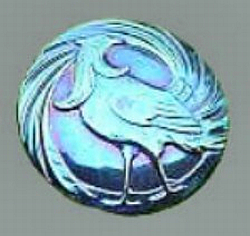 |
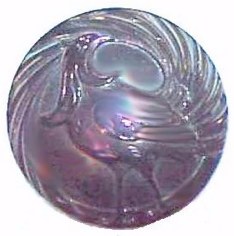 |
TOP O' THE WALK or Top O' the Morning Hatpin on Black Amethyst Glass
|
RING -TAILED PHEASANT named alternately as TOP O'THE MORNING on Black Amethyst Glass.
|
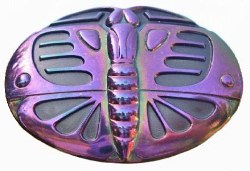 |
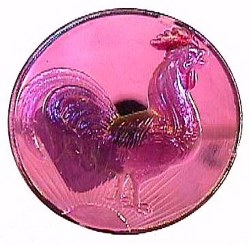 |
SUN'S UP Hatpin on Raspberry-Red Glass
|
|
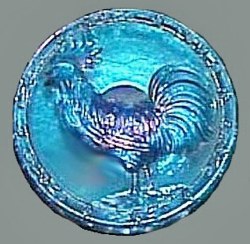 |
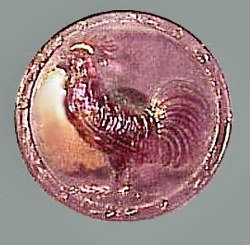 |
ROOSTER Hatpin in Celeste Blue
|
ROOSTER Hatpin in Lavender
|
Jerry Reynolds'story ( in her own words):
During my years of collecting carnival glass hatpins and holders I have run across duplicate names, incorrect identifications and unusual designs with no names. Two of the names most often confused are BUTTERFLY and SCARAB. Depending upon the author, these have also been called BIG BUTTERFLY. Button collectors call it Art Nouveau Butterfly, although it is not an art nouveau style.
RING-TAILED PHEASANT @ a diameter of 1 ½” and Top of the Walk become confusing names, but this is typical of the art nouveau period which was in full bloom at the beginning of our hatpin era and changed into art deco at its close. Art Nouveau was full of swirling lines and exotic, overblown treatment of flowers and insects, while art deco was a pull back to cleaner lines with a stylized accent, as a reaction to the “wildness” of art nouveau.
One of the reasons for the overlap of buttons and hatpins is that most of the heads from both pins and buttons in iridescent glass were made in Joblonec, Czechoslovakia, according to the hatpin lady, Lillian Baker. Lillian worked with Marion Hartung in listing the hatpins. Because Marion limited carnival to American glass, Lillian labeled these items as iridescent and tried not to call them carnival glass. The overlapping use of the terms hatpin and/or buttons evolved from the fact that all of these heads had glass cones on the reverse side. They were boxed in Europe and sent to their destination where they were fitted with the metal shank of a hatpin or the metal, looped shank of a button. As they were used as both hatpins and buttons, I see no problem with either label.
The DECO BUTTERFLY is 1 7/8” long and 1 ½” wide on heavy black glass and has many dark, iridescent colors which brings up an interesting statement by Rose Presznick concerning these heads. She lists them in green, blue and purple, but says they all are on a red, black glass base. She must be describing the iridized result which we know varies from item to item. When looking for color from Presznick be wary. I have not seen this pin nor heard of it in any base color other than black.
Rather than Top of the Walk or Chanticleer, ROOSTER simplifies and ends confusion, seeming to be the best name to use! This head is 1 ½” across and is found in white, marigold, aqua, ice blue, green, purple and a good red. During the time they were in use many of these heads had been treated with a flat black paint around the rooster and red enamel on the comb. When boxes were discovered in a “warehouse find” at a later time, none of the pins had been treated with black paint. They must not have shown up well unless emphasized by the blackness. The iridescence is good under the black paint. If you wish to remove it, use fingernail polish remover.
SUN'S UP displays another rooster facing the opposite direction, standing on a well-defined, many rayed sun, with no decorative edge on the pin head.
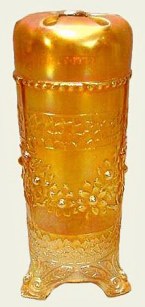 |
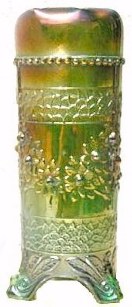 |
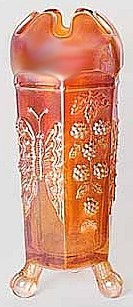 |
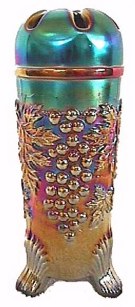 |
Fenton FOOTED ORANGE TREE Hatpin Holder in marigold.
|
VERY Rare Green FOOTED ORANGE TREE Hatpin Holder
|
Fenton mgld. BUTTERFLY & BERRY Hatpin Holder.
|
Northwood GRAPE & CABLE BANDED Hatpin Holder in Amethyst.
|
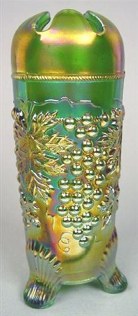 |
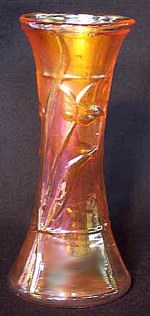 |
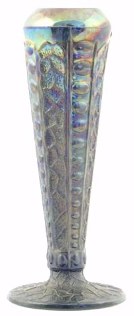 |
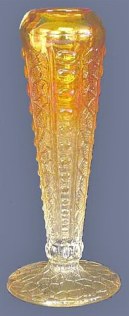 |
Standard GRAPE & CABLE Hatpin Holder in Green.
|
5 in. tall with a 2.25 in. base. WOODLANDS Hatpin Holder...Maker uncertain.Smoke and mgld.
|
FORMAL Hatpin Holder in Amethyst - 7 in. tall x 2 in. diam. By Dugan
|
FORMAL Hatpin Holder in Mgld. is more scarce than amethyst.
|
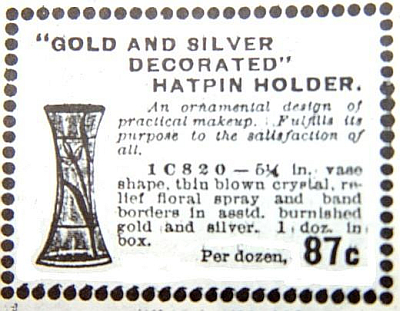 |
|||
This Oct. 1909 Butler Bros. Catalog ad refers to this piece as a HATPIN HOLDER.So, we stand corrected! This has been referred to as a VASE.
|
|||
HATPIN HOLDERS
Carnival Glass collectors who collect hatpins and holders recognize three hatpin holders without question. On the subject of the fourth, however, there are varying opinions, so it is to that end that this article is being written.
The three most readily recognized are Orange Tree and Butterfly and Berry by Fenton, and Grape and Cable by Northwood. The distinctive feet on these holders would tell you what they were if the patterns were worn off!
The Orange Tree has sharp angled feet like those used on Footed Orange Tree items, along with the usual “busy” Fenton design. It comes in amethyst, blue, marigold, is rare in green and white, with a very rare, one of a kind, peach opalescent.
The Grape and Cable (usually has the N in a circle) features a smooth flowing foot with a shell-like design. The holder can be found in marigold, purple, scarce green, ice green, ice purple, ice blue, very scarce cobalt and an extremely rare (only one?) aqua opalescent.
This hatpin holder is also found having a band rather than the cable at the top. This is referred to as Grape and Cable Banded.
Butterfly and Berry has the most interesting feet of all. They look like the ball and claw furniture feet of the same era. As far as we know these are only found in marigold and blue, and are very scarce in either color.
Woodlands is a very short 5 inches in height, is listed in and called a hatpin holder in a Butler Bros. Wholesale ad. It is difficult to question advertising mediums. However, many carnival glass collectors will no doubt find fault with this, since this piece has been called a “vase”, many times over! Obscure as it is, they are found mostly in marigold, with an occasional smoke example surfacing. Manufacturer is unknown. These scarce holders have been seen on occasion, having stenciled advertising on, indicating after-market use for promotional purposes.
Formal hatpin holders are another design from Dugan which has been called a bud vase. These are popular pieces and whether in marigold or amethyst, prices are quite respectable! Supposedly, the jack-in-the-pulpit shape in this pattern is the vase. The ones having the cupped in top are referred to as hatpin holders. Neither shape is often found. This was a very early pattern for Dugan, carried over from the opalescent period.
Dean & Diane Fry - 5/06
     |
“You are the Christ, the Son of the living God” (Matthew 16:16)
“The Christ” refers to “the anointed one,” the Greek word for the Jewish Messiah. And “The Son of the living God” makes reference to Jesus' divine nature (Isaiah 9:6; Jeremiah 23: 5-6; Micah 5:2).
This now famous proclamation had been given to Peter from above, as he had previously witnessed the miracles and teaching of Jesus.
|
     |
Should you care to contact the Frys, their email address is:
Search Our Sites
back to Carnival Glass 101
Our other sites you may enjoy:
Everything you EVER wanted to know about Indiana Glass
Great Reference for Newer Carnival Glass.
Complete Glassware Catalogs Available to Download
Questions? Comments? Suggestions? Broken Links? Corrections?
Your Friendly Webmaster is here to help!
